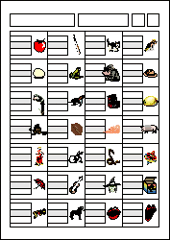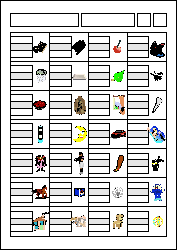
There is a bird in a poem by T. S. Eliot who says that mankind cannot bear very much reality; but the bird is mistaken. A man can endure the entire weight of the universe for eighty years. It is unreality that he cannot bear.
Ursla Le Guin (1929-2018)
The Lathe of Heaven, 1971
Assessment Sheets
One thing I do with elementary school aged children is introduce them to the idea of self-assessment. To this end I have some assessment sheets that children are asked to complete within one minute. Each sheet usually has 28 items.
![]() At the top of each sheet there are two boxes to record name and date. There
are also two square boxes. In the first the child would write a presonal
target - a predicted score. The second is used to record the actual result. Ideally
the numbers will be the same or very similar.
At the top of each sheet there are two boxes to record name and date. There
are also two square boxes. In the first the child would write a presonal
target - a predicted score. The second is used to record the actual result. Ideally
the numbers will be the same or very similar.
Anyone who has read my Think Tank commentary Do You Do Tests? will know that I find the idea of testing children abhorant. But how is using this assessment sheet any different?
Certainly it is important that a child be given the choice about whether to particpate or not. I think it would be very wrong to force a child to take such an assessment. Having said this the fact that children are required to make a personal target makes a significant difference.
The personal target encourages children to think closely about what they do know rather than think about what they may feel they should know. When I introduce this sheet for the first time I spend considerable time getting children to understand that I don't expect them to get a perfect score. This would be practically impossible as I always introduce the sheet before we have gone through all the relevent items in class.
I ask the childern to look at the sheet and decide a target after doing so. I also make sure they are clear that they only have one minute. I accept any target the children come up with. Most children underestimate their ability and score low, though sometimes a child will predict a wildly high score. I get the children to take the assesment using a pencil.
After time is up we go through the sheet. Since I work with small groups I have taken to writing out the sheet one letter at a time. Children use a felt tip pen (the colour of their choice) and tick answers that are correct and write any missing answers or answers that are incorrect.
Children tot up the number of correct answers and then I quickly go through the sheets comparing targets with results. I never compare one child's score with another. I focus entirely upon the difference between the predicted score and hte result. If a child predicted 1 out of 28 and scored 1 that would be a good result in my eyes. Where a child scores much more than the target I will praise the result but mainly focus on the fact that the target is "too small". Similarily, on the odd occasion that a child has scored much less than a target I suggest that the target was "too big".
I like to encourage effort but I mainly focus on getting children to make a good target. It is this that changes it from a test into an assessment.
Here are some notes about the two assessment sheets I use most frequently:
Alphabet Check
 This has 28 symbols, the last two being question mark and exclamation mark.
This has 28 symbols, the last two being question mark and exclamation mark.
Most of these words work pretty well as far as helping children to associate words with particular sounds. For 't' I used to use the word truck but I've now changed this to top. I wonder about the word 'yes' for y. Perhaps I should use yak? Or possibly yen (as in the currency). I'm also wondering about creating a completely new one with as many three letter words and balance of vowels as possible. It's all too easy to use up a lot of time playing around with alphabets.
Double Letter Check
I guess I've spent even more time fiddling with this one. This is the latest version. Here is a complete word list:
ph - phone
ai - rain
ie - pie
ue - glue
ir - girl
or - horse
ou - house
ck - black
ay - tray
oa - coat
oo - moon
ur - nurse
oo - book
ow - cow
ch - cherry
ea - leaf
ow - window
ar - car
au - sauce
oi - coin
air - chair
sh - ship
ee - bee
ew - screw
er - merman
aw - straw
oy - boy
all - ball
| ph | - | phone |
| ck | - | black |
| ch | - | cherry |
| sh | - | ship |
| ai | - | rain |
| ay | - | tray |
| ea | - | leaf |
| ee | - | bee |
| ie | - | pie |
| oa | - | coat |
| ow | - | window |
| ew | - | screw |
| ue | - | glue |
| oo | - | moon |
| ar | - | car |
| er | - | merman |
| ir | - | girl |
| ur | - | nurse |
| au | - | sauce |
| aw | - | straw |
| or | - | horse |
| oo | - | book |
| oi | - | coin |
| oy | - | boy |
| ou | - | house |
| ow | - | cow |
| air | - | chair |
| all | - | ball |
 Why this particular set of letters, why these paticular words? I have some
answers but none completely satisfactory. Originally the word for ph was phonics
and it came first as a kind of title. But there was no simple grphic for the
word and phone is much more useful. However, usefulness hasn' t been a priority.
For example originally I had dream and sleep rather than leaf and bee but these
two together proved confusing. I used to include May and August but turned
against them because they include capital letters. A couple of more recent
changes include cherry and merman. I decided to use cherry rather than chicken
because chi is a recognised sound in Japanese where-as che isn't. Merman is
a replacement for mermaid. At first I used boxer but this just didn't prove
memorable. I switched to mermaid and stuck with that for a while but was unhappy
because it included ai as well as er. After that the word fern made a brief
appearance but was too confusing (being seen as another leaf) and just not
very interesting. It's too early to say how effective merman will be. One can
hope.
Why this particular set of letters, why these paticular words? I have some
answers but none completely satisfactory. Originally the word for ph was phonics
and it came first as a kind of title. But there was no simple grphic for the
word and phone is much more useful. However, usefulness hasn' t been a priority.
For example originally I had dream and sleep rather than leaf and bee but these
two together proved confusing. I used to include May and August but turned
against them because they include capital letters. A couple of more recent
changes include cherry and merman. I decided to use cherry rather than chicken
because chi is a recognised sound in Japanese where-as che isn't. Merman is
a replacement for mermaid. At first I used boxer but this just didn't prove
memorable. I switched to mermaid and stuck with that for a while but was unhappy
because it included ai as well as er. After that the word fern made a brief
appearance but was too confusing (being seen as another leaf) and just not
very interesting. It's too early to say how effective merman will be. One can
hope.
What I may do in the future is add some more and then divide the total into part one and part two.
It goes without saying that children should be fully comfortable with single letters before introducing something like this.
Last updated 26th February 2005
getfile: Assessment Sheets
Alphabet Challenge SheetPDF: B5, 1 page, 591 KB Double Letters Challenge Sheet
PDF: B5, 1 page, 606 KB
- Top Page
- Splog!
- Articles
- Games
- Across The Table
- Add One More
- Anaconda
- Be A Monster!
- Black Hole (board game)
- Bombs Away!
- Catch!
- Catch-Caught-Caught!
- Centipede
- Charades
- Co-operative Quiz
- Crocodile
- Dice Stack
- Fast Food Tag
- Find My Number
- Find The Penny
- Football
- The Happy Game
- Line Up!
- Maze Challenge
- Natty Narration
- Nose Nose Nose
- One Step Forward!
- Pair Fluency Match 7 - Death Wish
- Pair Fluency Match 7 - Go Green!
- Parrot Parade
- Passport Control
- Reach The Top!
- Snake
- SockIt!
- Tickle Time
- What Cards
- Which One?
- Whose Shoe?
- World Cup Football 2018
- You, You, Me!
- Wake Up
- Packs
- Sheets
- Songs and Music
- Strips (songs and otherwise)
- Stories
- Techniques
- Video
- Environment
- Japan
- The 75th Anniversay of the bombing of Hiroshima
- The 75th Anniversay of the bombing of Nagasaki
- Cars in Japan
- Coronavirus Olympics
- Forest Bathing
- Japan and the Summit
- Japan and World War Two
- Multiculural Japan?
- Olympics Two Tokyos
- Plastic in Japan
- Return to Fukushima
- The Anniversary too Important to Cancel
- Typhoon Jebi
- Yayoi Kusama's Infinity
- Other
- This Week In History
- January, February, March
- April, May, June
- Sub Menu Item
- This Week in History: April 8-10
- This Week in History: April 12-15
- This Week in History: April 19-24
- This Week in History: April 24-26
- This Week in History: May 6-11
- This Week in History: May 11-14
- This Week in History: May 18-23
- This Week in History: May 25-31
- This Week in History: June 1-5
- This Week in History: June 11-14
- This Week in History: June 22-27
- This Week in History: June 15-21
- This Week in History: June 29 - July 5
- July, August, September
- This Week in History: July 6-12
- Sub Menu Item
- This Week in History: July 14-19
- This Week in History: July 27-31
- This Week in History: August 2- 6
- This Week in History: August 17-21
- This Week in History: August 27-30
- This Week in History: August 31 - September 6th
- This Week in History: September 7-13
- This Week in History: September 22-27
- This Week in History: September 14-20
- This Week in History: September 28 - October 4
- October, November, December
- Quizes
- Vocab



